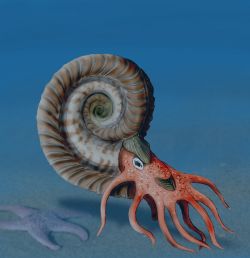| Hildoceratinae Temporal range: | |
|---|---|
 | |
| Reconstruction of Hildoceras | |
| Scientific classification | |
| Kingdom: | Animalia |
| Phylum: | Mollusca |
| Class: | Cephalopoda |
| Subclass: | † Ammonoidea |
| Order: | † Ammonitida |
| Family: | † Hildoceratidae |
| Subfamily: | † Hildoceratinae Hyatt, 1867 |
| Genera | |
See text | |
| Synonyms | |
Mercaticeratinae Guex, 1973 | |
Hildoceratinae is an extinct subfamily of cephalopods belonging to the family Hildoceratidae. Ammonites of this subfamily had shells with elliptical or quadrate whorl section with keel or tricarinate, bisulcate venter. Ribs were variable, from falcate to strongly angled and from fine to strong. They can be interrupted by spiral groove in midlateral part of the shell. While some species can be smooth, strongly ribbed ones can have tubercules. Microconchs have short lappets that is in its shape similar to the shape of growth lines in spiral midlateral groove. [1]